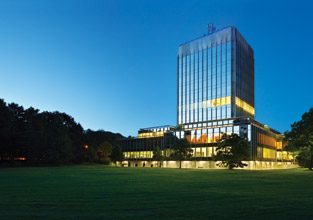
IgCC Advances Sustainability Practices
First Edition of International Green Construction Code Published
A three-year collaborative development process has culminated in the publication of the IgCC, which includes numerous ASTM International standards from 13 committees.
The decisions we make today regarding safety and sustainability - particularly those related to new and existing buildings, construction and energy - affect everyone's future. Many standards development organizations like ASTM International and code developers collaborate to ensure that stakeholders have the best resources and tools to address their safety and sustainability needs.
In March 2012, the International Code Council published the International Green Construction Code, known as the IgCC, after a three-year collaborative development process. The ICC developed this model code with the collaboration of members of the ICC Sustainable Building Technology Committee, which includes a variety of architectural firms, professional organizations, government representatives and standards development organizations such as the Air-Conditioning, Heating and Refrigeration Institute, the American Institute of Architects, the American Society of Mechanical Engineers, ASTM International, the Illuminating Engineering Society and the U.S. Green Building Council.
The IgCC serves as a model code focused on the safe and sustainable construction of new and existing commercial buildings. The code's effectiveness as a tool to increase energy efficiency and complement green building rating systems is demonstrated by the number of states and local jurisdictions that have adopted the code, either as a mandatory or optional requirement. Since 2011, Florida, Maryland, North Carolina, Oregon, Rhode Island and select jurisdictions in Arizona, Colorado, Florida and Washington have adopted either the IgCC as a whole or select provisions of it to meet the jurisdiction's needs.
IGCC References ASTM Sustainability Standards
There are 46 ASTM International standards cited in the code that represent the work of 13 ASTM technical committees:
- C16 on Thermal Insulation;
- D01 on Paint and Related Coatings, Materials and Applications;
- D07 on Wood;
- D08 on Roofing and Waterproofing;
- D18 on Soil and Rock;
- D19 on Water;
- D20 on Plastics;
- D22 on Air Quality;
- E06 on Performance of Buildings;
- E21 on Space Simulation and Applications of Space Technology;
- E33 on Building and Environmental Acoustics;
- E60 on Sustainability; and
- F26 on Food Service Equipment.
The IgCC references Committee E60's E2635, Practice for Water Conservation in Buildings Through In-Situ Water Reclamation, which describes an effective and relevant practice for water reuse in buildings while considering environmental, economic and social principles that affect all society. Through the use of technologies like in-situ water reclamation systems, the conservation of water enables a more sustainable use of water than in standard construction. Additionally, in-situ water reclamation systems help reduce building demand for potable water, thereby reducing burdens on municipal water supplies as well as utility costs and preventing moratoriums on new construction.
ASTM E1333, Test Method for Determining Formaldehyde Concentrations in Air and Emission Rates from Wood Products Using a Large Chamber, is also referenced in the IgCC. This test method from Committee D07 provides a standard means of testing certain typical building products permanently installed in manufactured and conventional homes. While formaldehyde, a colorless, pungent gas, is an important chemical in the manufacture of building materials and numerous household products, ASTM's test method helps to protect the health and safety of the public from the potentially detrimental health effects of overexposure to the gas.1 This test method is also used to determine compliance with federal requirements such as those established for building materials by the U.S. Department of Housing and Urban Development.2
The IgCC also references standards on soil and rock from ASTM Committee D18. ASTM D2974, Test Methods for Moisture, Ash and Organic Matter of Peat and Other Organic Soils, is performed to determine the organic content of soils. Organic matter influences and links many of the physical, chemical and biological properties of soils by affecting the soil's water holding capacity, nutrient contributions, biological activity and water and air infiltration rates. Organic content can aid the growth of crops by improving the soil's ability to store and transmit air and water; it also mitigates the negative environmental effects of pesticides, heavy metals and other pollutants by binding contaminants.
Each of these standards, along with those from other standards development organizations, plays a critical role in advancing global sustainability and protecting public health and safety. The IgCC and the many ASTM standards referenced in it serve as a relevant and comprehensive tool and resource for policymakers, industry leaders, environmental advocates and the public. ASTM is pleased to have contributed to the IgCC and looks forward to continuing these important efforts through the development of new standards that enable innovation and the environmentally improved commercial buildings of the future.
References
1. U.S. Environmental Protection Agency, "An Introduction to Indoor Air Quality (IAQ): Formaldehyde," www.epa.gov/iaq/formaldehyde.html.
2. U.S. Department of Housing and Urban Development, 24 CFR 3280, Manufactured Home Construction and Safety Standards.
Sarah Petre is manager of government and industry affairs for ASTM International.
 SN Home
SN Home Archive
Archive Advertisers
Advertisers Masthead
Masthead RateCard
RateCard Subscribe
Subscribe Email Editor
Email Editor